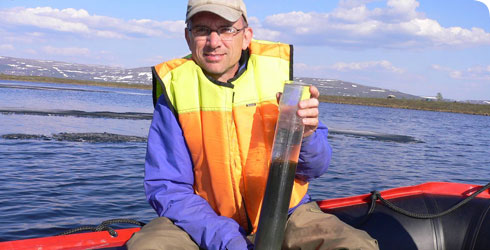Sediment cores
Museum scientist Steve Brooks takes sediment cores from the bottom of lakes and uses them to study populations of midges that lived in northern Europe and Siberia from the end of the last ice age to the present day.
He visits lakes in these areas and takes sediment cores from beneath the lake. The cores are sliced at 1cm intervals and a typical slice contains several hundred midge larvae.
Once Steve has identified the species of each larva, he can use this information to work out what the temperature was like when that sediment sample was deposited.
Midges and temperature
We know which types of midges live in which climatic conditions by studying the distribution of midges today.
Steve can use this information to help him analyse the sediment cores. If the core contains a high proportion of midge larvae that like to live in warm conditions then the temperature must have been quite high when the sediment was formed.
Sediment cores contain remains of other insects as well as midges and these can also help scientists to understand the temperature conditions when they were deposited.
Rapid temperature changes
The end of the last ice age is an interesting period of climatic history to study, because it was a time of rapid temperature change. Around 11,000 years ago, the temperature rose by as much as 4°C in just a few years.
Midges are a useful measure of rapid temperature change because their populations respond very quickly to changes in climate.
Recent studies show that temperatures today are also changing very rapidly.
Toolbox

The Museum's smallest members of staff are our flesh-eating beetles, Dermestes maculates, who strip carcasses to the bone.

